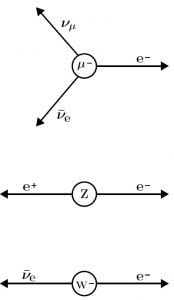Locality Problems of Massive Quantum Particles
The uncertainty principle implies that quantum theories cannot define a precise value for the location of a quantum particle. Hence, quantum functions yield an expression for the probability density of the particle’s location.
Fig. 1 depicts the decay modes of three motionless particles. For example, an electron-positron is one of the decay modes of the ![]() boson. The outgoing particles are detected by the pertinent devices and their position and momentum show that they emerged from a svery small space-time region. Therefore, in order to explain such a process, a quantum theory of a specific kind of particles should provide a consistent expression for spatial density.
boson. The outgoing particles are detected by the pertinent devices and their position and momentum show that they emerged from a svery small space-time region. Therefore, in order to explain such a process, a quantum theory of a specific kind of particles should provide a consistent expression for spatial density.
Density is a mathematically real 0-component of a 4-vector (see [1] pp. 73-78; [2], pp. 23, 24) that has the dimension ![]() . These properties impose restrictions on an acceptable expression for density. These constraints are relevant to the following discussion which examines quantum theories.
. These properties impose restrictions on an acceptable expression for density. These constraints are relevant to the following discussion which examines quantum theories.
- It is now recognized that the neutrino is a massive particle (see [3], p. 1307, [4]). Therefore, it is assumed here, that the neutrino is a Dirac particle (see item 2 below). The Dirac theory provides a consistent expression for density and for

Figure 1: Leptonic decay of particles (see text).
its associated 4-current
![]() (1)
(1)
(see [2], p. 24). Here ![]()
The upper part of fig. 1 comprises only Dirac particles. Therefore, the Dirac theory explains density issues of muon decay.
- Let us examine the Majorana theory of the neutrino. This theory uses four
 matrices that comprise only pure imaginary numbers [5]. Therefore, the function that solves the Majorana equation is real. However, the pure imaginary
matrices that comprise only pure imaginary numbers [5]. Therefore, the function that solves the Majorana equation is real. However, the pure imaginary  means that the Majorana 4-current (1) is also pure imaginary. The Majorana theory is therefore inherently wrong, because it has no acceptable expression for density.
means that the Majorana 4-current (1) is also pure imaginary. The Majorana theory is therefore inherently wrong, because it has no acceptable expression for density.
Experimental data support this result. For example, a neutrinoless double beta decay is a typical Majorana process. And indeed, in spite of many experimental efforts, “modern searches have found no evidence for the decay” [6].
- The
 decay of fig. 1 shows two outgoing Dirac particles whose location has a well-defined theoretical expression. However, the electroweak literature does not show a consistent expression for the
decay of fig. 1 shows two outgoing Dirac particles whose location has a well-defined theoretical expression. However, the electroweak literature does not show a consistent expression for the  boson density.
boson density. - The
 decay of fig. 1 shows two outgoing Dirac particles whose location has a well-defined theoretical expression. However, the electroweak literature does not show a consistent expression for the
decay of fig. 1 shows two outgoing Dirac particles whose location has a well-defined theoretical expression. However, the electroweak literature does not show a consistent expression for the  boson density.
boson density.
Research topic #1: Can the density-related discrepancy of the Majorana theory be resolved?
Research topic #2: Can the density-related discrepancy of the electroweak ![]() theory be resolved?
theory be resolved?
Research topic #3: Can the density-related discrepancy of the electroweak ![]() theory be resolved?
theory be resolved?
Remark: A consistent expression for density is a crucial element of quantum mechanics as well as of quantum field theories. Indeed, a respectable textbook sustain with this claim. “First, some good news: quantum field theory is based on the same quantum mechanics that was invented by Schroedinger, Heisenberg, Pauli, Born, and others, in 1925-26, and has been used ever since in atomic, molecular, nuclear and condensed matter physics” (see [7], p. 49).
References
[1] L. D. Landau and E. M. Lifshitz The Classical Theory of Fields (Elsevier, Amsterdam, 2005).
[2] J. D. Bjorken and S.D. Drell, Relativistic Quantum Mechanics (McGraw-Hill, New York, 1964).
[3] J. A. Formaggio and G. P. Zeller, Rev. Mod. Phys. 84, 1307 (2012).
[4] http://pdg.lbl.gov/2018/reviews/rpp2018-rev-intro-neutrino-prop.pdf
[5] P. B. Pal, Am. J. Phys., 79, 485 (2011).
[6] https://en.wikipedia.org/wiki/Double_beta_decay#Status
[7] S.Weinberg, The Quantum Theory of Fields, Vol. I (Cambridge University Press, Cambridge, 1995).
